Victor Cioană (23-01-1939 - 07.01.2010) Romanian composer and player
 |
Victor (on the left)
analyzing an endgame with Dieter Klosterman |
Victor Cioană was the best solver in his hometown Suceava. Victor won several times the solving tourney organized by Romanian magazine "
Revista Română de Şah”. It was only natural for him to publish his first problem in this same magazine. It was a helpmate in 4 with 2 solutions.
Cioană, Victor
Revista Română de Şah, 1988

Show Solution1.Be4 Bg8 2.Bh7 e4 3.Kg6 Kf8 4.f6 Bf7#
1.Bf3 Bxd3 2.Bh5 e4 3.Kg6 e5+ 4.f5 exf6 e.p.#
Indian.
Another helpmate in 4 with two solutions, composed soon before Victor left us:
Cioană, Victor
Probleemblad, 2010
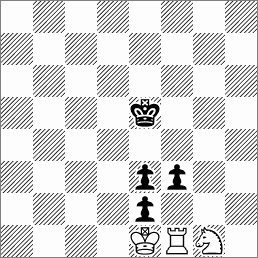
Show Solution1.Kd4 Rf2 2.Kc3 Sxe2+ 3.Kb2 Sc3+ 4.Ka1 Ra2#
1.Kf4 Sxf3 2.Kg3 Kxe2 3.Kg2 Rf2+ 4.Kh1 Rh2#
Chameleon echo mates.
Luigi Ceriani is renowned for his retro problems and for the theme that wears his name, but he also composed selfmates or directmates. More than 600 of his problems can be seen
on the Chess Problem Database Server.
Readers may consult online Nikita Plaksin and Igor Vereshchagin's article about Luigi Ceriani's retro works in
Best Problems : the article can be seen
here.
Luigi Ceriani also wrote two books, "
32 Personaggi e 1 Autore" (1955) and "
La genesi delle posizioni" (1961), about chess
retroanalysis.
Ceriani, Luigi
46 32 personaggi e 1 autore 1955
| What happened to wPa2? | | 14 + 11 |
Show SolutionRetro: 1... Kf5-e4; 2.g3-g4+ Kf6-f5 3.Bg4-h5 Ke7-f6 4.Bc8-g4 Kf8-e7 5.d7xBc8=B Ke8-f8 6.c6xQd7+ Qd8-d7 7.c5-c6 d7-d6 8.b4xBc5 Bf8-c5 9.c3-c4 d6-d5 10.c2-c3 e7xBd6 11.Be5-d6 a2-a1=B 12.Bc3-e5 a3-a2 13.Bd2-c3 a4-a3 14.Bc1-d2 a5-a4 15.d2xSe3 Sf5-e3+ 16.b3-b4 Rc3-f3 17.Rf3-f2 etc.
Stig Leopold Björklund (23-01-1917 - 15-10-2005) Swedish composer
Two problems with Black self interferences:
Björklund, Stig Leopold
Springaren, 1963
1
st Prize
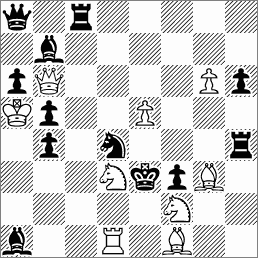
Show Solution1.g7 ! (2.Qxh6+ Rxh6 3.Bf4#)
1...Bc6/Rh8/Rf8 2.Sb2 (3.Rd3#) 2...Be4 3.Qxd4#
1...Rc6 2.Sf4 (3.Sd5/Rd3#) 2...Rf4/Rc6~/Qg8/Qd8 3.Rd3#
Björklund, Stig Leopold
Tidskrift för Schack, 1950
3
rd Prize

Show Solution1.Qb2 ! (2.Sd5#)
1...Be5 2.b8=S (3.Sd7#)
1...Se5 2.b8=Q (3.Qd8#) 2...Se5~ 3.Sd5#
1...Re5 2.gxf7 (3.f8=Q/R#) 2...Re5~, Rxe4 3.Sd5, Sxe4/Sd5#
1...e5 2.Qb5 (3.Qc6#)
1...Ke5 2.Sb5+ c3 3.Qxc3#
5 black defences on the same square (e5) after a flight-giving key with battery creation.
Also notable is the wQ switchback to b5 after 1...e5 and the exchange of places between wQ and wS in the variation 1...Ke5.
Miroslav Stošić (23-01-1949 - 11-01-1975) Yugoslav composer
A book of his selected problems was published in 1979: "
Miroslav Stošić - Izabrani problemi".
Probably the highest distinction obtained by the great Yugoslav composer was the following problem:
Stošić, Miroslav
1
st WCCT, 1972
2
nd Place, 1972-1975
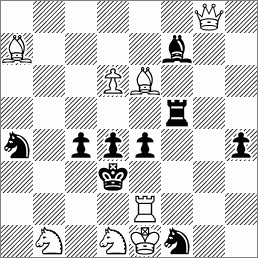
Show SolutionSet play:
1...Sb2/Sb6/Sc3/Sc5 2.Sxb2#[A]
1...Sg3/Sh2/Se3/Sd2 2.Rd2#[B]
1...e3 2.Bxf5#
1...Rf2/Re5/Rd5/Rc5/Rb5/Ra5/Rg5/Rh5 2.Sxf2#[C]
1...Bg6/Bh5/Be8 2.Bxc4#
Tries:
1.Qg7? (2.Qxd4#)
1...Sb6/Sc5 2.Sb2#[A]
1...Re5/Rd5/Rc5 2.Sf2#[C]
1...Sd2 2.Rxd2#[B]
but 1...Rf6!
1.Qg4? (2.Qxe4#)
1...Sc3/Sc5 2.Sb2#[A]
1...Sg3/Se3/Sd2 2.Rd2#[B]
1...Re5 2.Sf2#[C]
1...e3 2.Qxd4#/Qxf5#/Bxf5#
but 1...Rf4!
1.Qg3+?
1...Sxg3/Se3 2.Rd2#[B]
1...e3 2.Bxf5#
1...Rf3 2.Sf2#[C]
but 1...hxg3!
1.Qc8? (2.Qxc4#)
1...Sb2/Sb6/Sc5 2.Sxb2#[A]
1...Se3/Sd2 2.Rd2#[B]
1...Rd5/Rc5 2.Sf2#[C]
1...e3 2.Bxf5#
but 1...Bxe6!
1.Qa8? (2.Qxe4#)
1...Sc3/Sc5 2.Sb2#[A]
1...Re5/Rd5 2.Sf2#[C]
1...Sg3/Se3/Sd2 2.Rd2#[B]
1...e3 2.Bxf5#
but 1...Rf4!
1.Qh8? (2.Qxd4#)
1...Sb6/Sc5 2.Sb2#[A]
1...Sd2 2.Rxd2#[B]
1...Re5/Rd5/Rc5 2.Sf2#[C]
but 1...Rf6!
1.Qxf7? (2.Bxc4#)
1...Sb2/Sb6 2.Sxb2#[A]
1...Se3/Sd2 2.Rd2#[B]
1...Rd5/Rc5 2.Sf2#[C]
1...e3 2.Bxf5#/Qxf5#
but 1...Rxf7!
1.Qg1! (2.Qxd4#)
1...Sb6/Sc5 2.Sb2#[A]
1...Se3/Sd2 2.Rd2#[B]
1...Rf2/Rd5/Rc5 2.Sxf2#[C]
1...e3 2.Bxf5#
Transferred mates.
Stošić, Miroslav
Makuc + Moder MT, 1970
1
st Prize
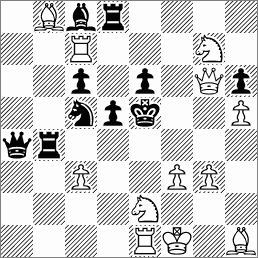
Show Solution1.Se8! (2.Qf6#)
1...d4 2.f4#
1...Rf4 2.Rd7#
1...Sd7 2.Sd4#
Interesting cycle of fields (d4-f4-d7-d4).
The following problem was quoted by Dragan Stojnić in his excellent Bristol article in Mat Plus Review.
Stošić, Miroslav
Шахматы в СССР 1973
4
th Prize
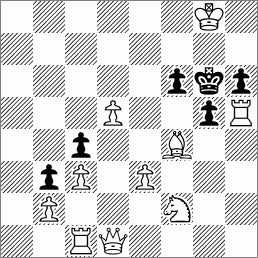
Show SolutionSet play:
1...gxf4[a]/g4 2.Qg4#[A]
Try:
1.Qh1? zz
1...gxf4[a] 2.Rg1#[D]
1...f5[b] 2.Rxh6#[B]
1...Kf5[c] 2.Qe4#[C]
but 1...g4!
1.Ra1! zz
1...gxf4[a]/g4 2.Qg4#[A]
1...f5[b] 2.Ra6#[F]
1...Kf5[c] 2.Qb1#[E]
Bristol,
changed mates.
Fontaine, Leon
Probleemblad, 1976 (7757)
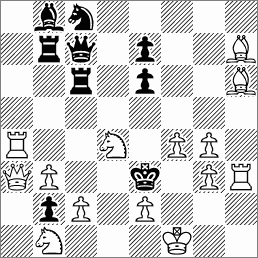
Show Solution1.Sb5! (2.Re4#)
1...Qe5 2.fxe5#
1...Qxf4+ 2.gxf4#
1...Sd6 2.f5#
1...Rc4 2.bxc4#
Pawn batteries.
Christoph Johannessohn (23-01-1917 - 27-03-1979) German composer
Johannessohn composed mostly logical problems.
Johannessohn, Christoph
Die Schwalbe, 1960
4
th Prize
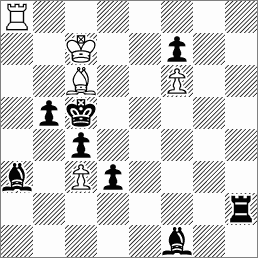
Show SolutionTries: 1.Rg8? Bc1!; 1.Rd8? Bg2!
1.Rb8 ! (2.Rxb5#)
After
1...Rb2 2.Rd8? would fail because of 2...Bg2! Hence:
2.Rg8! (3.Rg5#)
2...Rg2 3.Rd8 (threatens 4.Rd5# ; 3...Bg2 is now impossible)
3...Rg5 4.Rb8 ~ 5.Rxb5#
Rook
Rundlauf.
(Grigori Aronovich Shmulenson)
Шмуленсон, Григорий Аронович
Solidarity Ty, 2001
2
nd Prize

Show Solution1. Ke3
{1. Kd4 exd5 2. Ba6+ Kb8 3. Kxd5 Kxa8 4. Kxd6 Kb8}
{1. Bb5 exd5+ 2. Kd4 Kb7 3. Kxd5 a6}
1... exd5 2. Ba6+ Kb8 3. Kd4 Kxa8 4. Kxd5 Kb8 5. Kxd6 Ka8 6. Kc7 d5 7. Bb7#
A variation on an already well-known theme: see
d'Orville, 109 in Problèmes d'Échecs, 1842 for the first presentation of the idea and John D. Beasley's article "A tale of two bishops against one" on pages 6-7 in
BESN June 2006 for further versions in endgames studies.
D'Orville, Pierre Auguste
Problèmes d'Échecs, 1842 (109)

1.Ba6+! Kxb8 2.Kd6 Ka8 3.Kc7 d6/d5 4.Bb7#
Bo Jonsson (23-01-1950) Swedish composer
Bo Jonsson
Probleemblad 9-10 1969
2
nd Prize
Show Solution1. c1=B Kg1 2. Bf4 Kf1 3. Kh2 Sd6 4. Kh1 Se4 5. Bh2 Sf2#
2) 1. Kf2 Kh2 2. c1=R Kh3 3. Kg1 Sd6 4. Kh1 Se4 5. Rg1 Sf2#
Echo mates.
Pierre Bansac (23-01-1892 - 13-08-1978) French composer
Pierre Bansac
[in Thèmes 64 no.92, Oct-Dec. 1978] |
Pierre Bansac was the pseudonym of General Charles Rinderknech. He is famous for his contribution to chess problem theory by numerous articles published in French magazines and by his book "La théorie des effets appliquée au problème d'échecs" (1978).
He held regular columns in "L'Échiquier de Paris" from 1946 until 1953.
His best-known problem is the following:
Bansac, Pierre
1
st Prize
UPF 1945
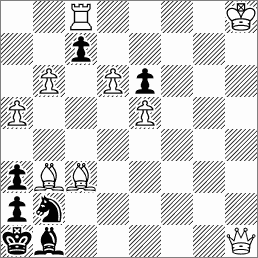
Show Solution1.♕d1! ZZ
1...c5 2.♕e1 c4 3.♗d1 ♗h7 4.♗c2#
1...c6 2.♗c4 c5 3.♕b3 ♗h7 4.♕xa2#
1...cxd6 2.♕xd6 ~ 3.♕xa3 ♗h7 4.♕xb2#
1...cxb6 2.♗xb2+ and two sub-variations:
2...♔xb2 3.♗xe6 h7 4.♕c1# or 3...♗c2 4.♖xc2#
2...axb2 3.♗xa2 (4.♕xb1#) 3...♔xa2 4.♕a4#
Pickaninny theme.
>
Ernst Carl Schaaf (23-01-1880 - 13-05-1985) German composer
Ernst Schaaf composed direct mates and selfmates. His problem were appreciated by solvers and easy to understand. He is probably the recordholder for the oldest active problemist since he stopped publishing problems in 1976 at the age of 96 (his last problem is
here) and died at the age of 105. More can be read about him in
Die Schwalbe 61/1980 pages 9-10.
An example of his pleasant problems:
Schaaf, Ernst Carl
Die Schwalbe 1955

Show Solution
1.♗g2! (2.f4+ ♔×h4 3.♗e1# or 2...♔×g6 3.♗e4#)
1...♔×g6 2.♗e4+ ♔g5 3.♘g2#
1...♔×h4 2.♘f5+ ♔g4 3.f3#










No comments:
Post a Comment